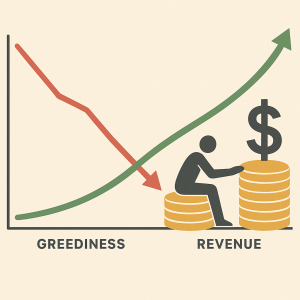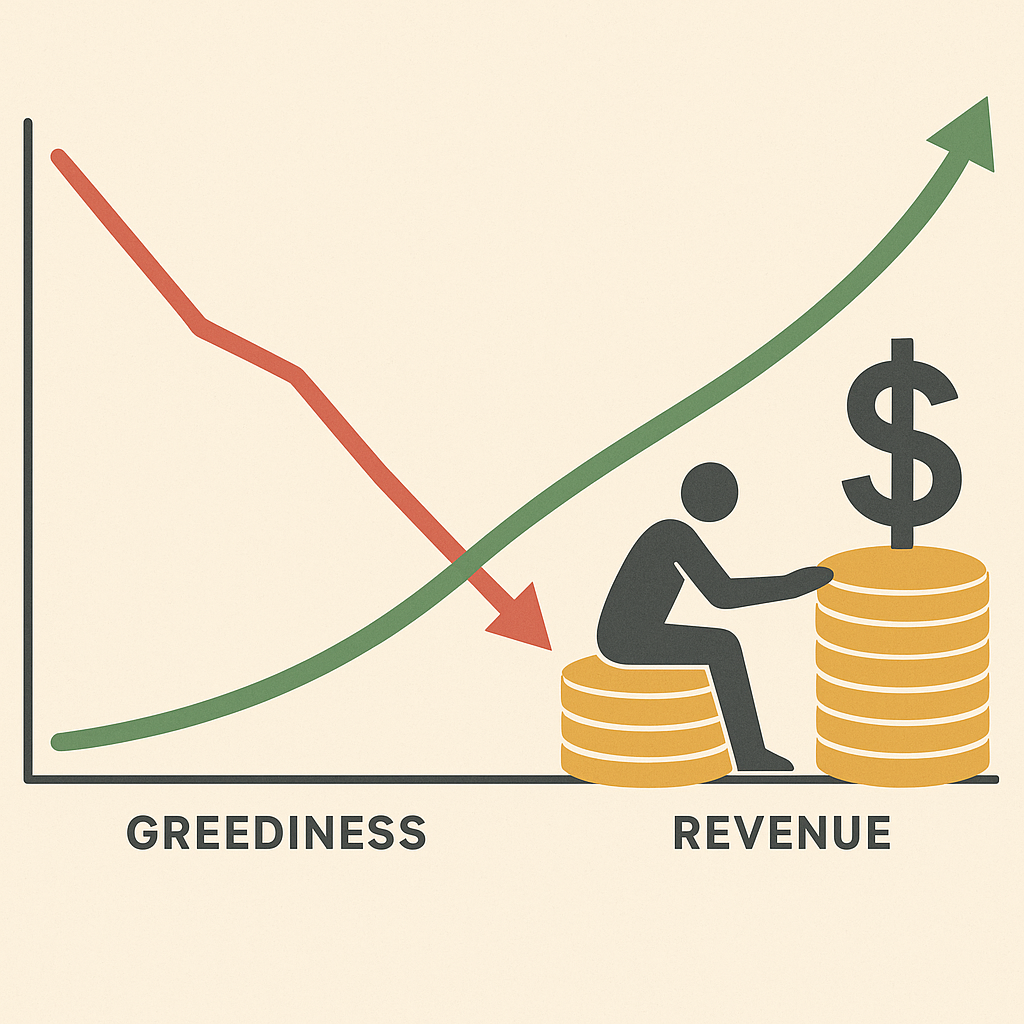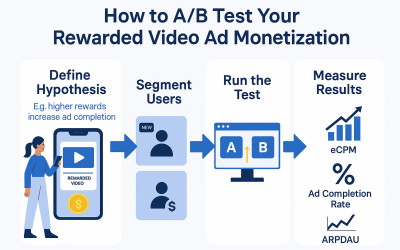The Monetization Paradox: Why Games That Feel Less ‘Greedy’ Make More Money
Contents
- 1 What is the monetization paradox in gaming?
- 2 Why do ‘non-greedy’ games actually make more money?
- 3 How do players perceive ‘greedy’ vs ‘fair’ monetization?
- 4 What are examples of successful ‘non-greedy’ monetization models?
- 5 How does psychology drive the monetization paradox?
- 6 What metrics prove non-greedy monetization works better?
- 7 How can developers implement non-greedy monetization strategies?
- 8 The Future of Game Monetization; AppLixir’s take
What is the monetization paradox in gaming?
The monetization paradox is a counterintuitive phenomenon where games that appear less aggressive in their monetization strategies actually generate more revenue per player than those that constantly push purchases. While conventional wisdom suggests that more frequent purchase prompts and aggressive pricing would lead to higher revenues, data consistently shows the opposite: players spend significantly more in games that make them feel respected rather than exploited.
This paradox challenges the traditional “squeeze every dollar” approach that dominated mobile gaming in the early 2010s and continues to shape how successful game developers think about long-term revenue generation.
Why do ‘non-greedy’ games actually make more money?
Trust builds bigger wallets
When players trust that a game respects their time and money, they’re paradoxically more willing to spend larger amounts. Games like Genshin Impact and Fortnite have mastered this balance by offering substantial free content while making premium purchases feel like genuine value additions rather than necessities.
The psychology behind this is straightforward: players who feel manipulated become defensive with their spending, while those who feel valued become generous. A player who trusts a developer is more likely to make that $50 cosmetic purchase because they believe they’re supporting a game that cares about their experience.
The compound effect of player retention
Non-aggressive monetization strategies create a compound effect through improved player retention. When players don’t feel constantly pressured to spend, they stay engaged longer, which dramatically increases the lifetime value (LTV) of each player.
Consider this scenario: Game A uses aggressive pop-ups and forces players into purchase decisions, resulting in 30% of players spending an average of $25 before quitting after 2 months. Game B uses subtle monetization with optional purchases, resulting in 15% of players spending but averaging $80 over 8 months of play. Game B generates significantly more revenue per user despite having a lower conversion rate.
How do players perceive ‘greedy’ vs ‘fair’ monetization?
The transparency factor
Players have become sophisticated in recognizing monetization tactics. They can distinguish between games that hide costs (greedy) and those that present clear value propositions (fair). Transparent pricing, honest communication about what purchases include, and avoiding bait-and-switch tactics all contribute to a “fair” perception.
Greedy signals players recognize:
- Pay-to-win mechanics that create unfair advantages
- Artificially inflated prices followed by “limited time” discounts
- Essential gameplay features locked behind paywalls
- Confusing virtual currency systems designed to obscure real costs
- Aggressive pop-up advertisements during gameplay
Fair monetization signals:
- Cosmetic-only purchases that don’t affect gameplay balance
- Clear, upfront pricing in real currency
- Generous free content that doesn’t feel incomplete
- Optional battle passes with transparent reward structures
- Respectful timing of purchase prompts
The emotional investment equation
When players perceive monetization as fair, they develop emotional investment in the game’s success. This transforms the spending dynamic from “I have to buy this” to “I want to support this.” This emotional shift is crucial because willing supporters spend more freely and frequently than reluctant customers.
What are examples of successful ‘non-greedy’ monetization models?
The Fortnite Formula
Epic Games revolutionized battle royale monetization by making the core game completely free while monetizing through cosmetics and battle passes. Players never feel forced to spend to remain competitive, yet Fortnite generates billions annually because players choose to express themselves through purchases.
The key insight: when gameplay advantages aren’t for sale, cosmetic purchases become guilt-free expressions of personality rather than necessary investments for competitiveness.
Genshin Impact’s Generous Foundation
miHoYo’s approach with Genshin Impact demonstrates how generous free content can drive higher spending. The game provides dozens of hours of high-quality content without requiring purchases, building trust that translates into willingness to spend on character banners and cosmetics.
Their monetization feels optional rather than mandatory, which paradoxically makes players more likely to engage with it voluntarily.
Path of Exile’s Ethical Framework
Grinding Gear Games built Path of Exile on explicitly ethical monetization principles, selling only cosmetics and convenience features while keeping all gameplay content free. This transparent approach has generated sustained revenue for over a decade and created one of gaming’s most loyal communities.
How does psychology drive the monetization paradox?
The reciprocity principle
When games provide value without immediate expectation of payment, they trigger psychological reciprocity. Players feel indebted to developers who have given them enjoyable experiences for free, making them more likely to “give back” through purchases when they can afford to do so.
 This reciprocity response is much stronger than the defensive reaction triggered by aggressive monetization tactics.
This reciprocity response is much stronger than the defensive reaction triggered by aggressive monetization tactics.
Autonomy and control
Players have a fundamental psychological need for autonomy in their decisions. When monetization feels coercive or manipulative, it threatens this sense of control, creating resistance. Conversely, when purchases feel entirely optional and player-driven, the same individuals become much more willing to spend.
Social proof and community dynamics
Games with fair monetization tend to develop stronger communities where spending is seen as positive community support rather than falling victim to predatory practices. This social dynamic encourages spending through positive peer influence rather than individual pressure tactics.
What metrics prove non-greedy monetization works better?
Long-term revenue per user (LTV)
While aggressive monetization might show higher short-term conversion rates, non-greedy approaches consistently demonstrate higher lifetime value per player. Industry data suggests that games focused on long-term player satisfaction can achieve LTV numbers 3-5x higher than those using aggressive tactics.
Player retention and engagement
Games with respectful monetization show significantly better retention curves. Six-month retention rates for non-aggressive games often exceed 25%, compared to 5-10% for games that heavily pressure players to spend early.
Organic growth and word-of-mouth
Perhaps most importantly, games that avoid greedy monetization benefit from positive word-of-mouth marketing. Players actively recommend games they feel respect them, reducing customer acquisition costs and creating sustainable growth loops.
How can developers implement non-greedy monetization strategies?
Start with value, not revenue
The most successful approach begins with creating genuine value for players before considering how to monetize that value. Ask “How can we make players happy?” before “How can we make players spend?”
Design optional, not essential purchases
Every monetization element should enhance rather than complete the core experience. Players should feel that they’re buying upgrades to an already satisfying experience, not purchasing the ability to properly enjoy the game.
Communicate transparently
Clear, honest communication about what purchases include, how the monetization system works, and why certain pricing decisions were made helps build the trust that drives long-term spending.
Measure beyond immediate conversion
Track metrics that matter for long-term success: player satisfaction scores, retention rates, community sentiment, and lifetime value rather than just immediate conversion rates and average revenue per user.
The Future of Game Monetization; AppLixir’s take
The monetization paradox isn’t just an interesting phenomenon—it represents the future of sustainable game revenue. As players become more sophisticated and markets become more competitive, games that master the balance between profitability and player respect will dominate those that prioritize short-term extraction over long-term relationships.
The most successful games of the next decade will be those that solve the monetization paradox completely: generating maximum revenue by making players feel valued, respected, and never exploited. In gaming, as in most relationships, treating people well isn’t just the right thing to do—it’s also the most profitable strategy.

